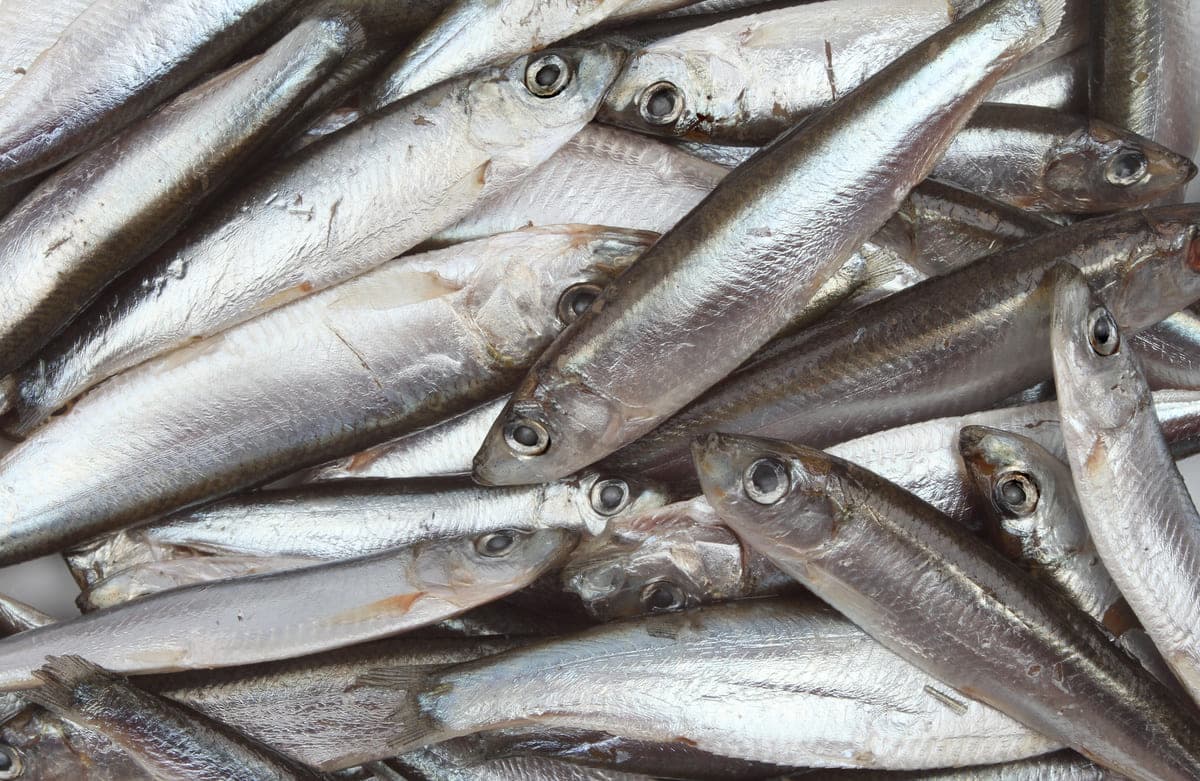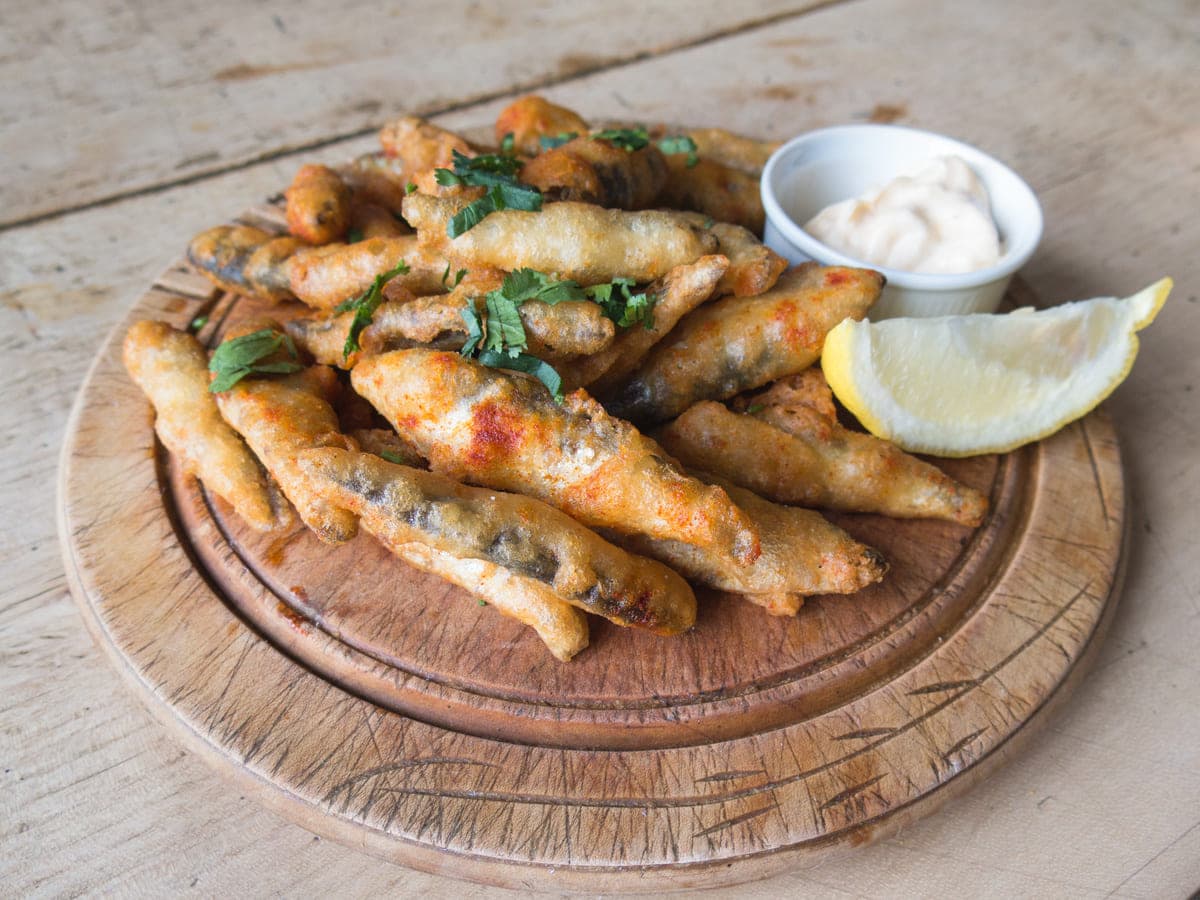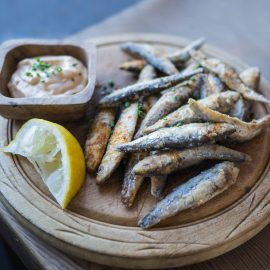
Introduction
Whitebait, a term derived from an old English word meaning white fish, is a collective name for the immature fish of various herring species and other fish species. These tiny fish are generally found in estuarine and coastal waters worldwide, making them an essential part of marine food webs.
For centuries, whitebait has been highly valued as a delicacy in many countries due to its distinct flavour and texture. In some regions, it is now farmed, which has led to increased production and availability.
Description & Characteristics
Whitebait are small fish, usually of the genera Alosinae or Alepocephalus, commonly found in coastal waters. They have a distinctive appearance; they are typically silver fish or transparent and measure around 5 centimetres long.
Whitebait has a single dorsal fin near their heads and a short anal fin on their backs. They also have large eyes and an elongated body shape. Whitebait can be distinguished from other fish species by their small size and transparent colouration.
Here are some interesting facts about whitebait:
1) Whitebait can be sold fresh or frozen and is usually sold whole with heads on;
2) Whitebait is often used as bait for larger fish due to its strong scent and attractive colouration.
Habitat And Distribution
Whitebait, a group of small fish species, is known for its wide distribution across the world’s oceans. They typically inhabit coastal and estuarine waters, although some species can be found in deeper water habitats.
Figuratively speaking, whitebait is the “hidden gold” of the ocean – a treasure trove of nutritional goodies that many cultures have enjoyed for centuries.
Most whitebait species inhabit temperate waters, some being found in tropical areas. Many have an annual migration pattern that includes spawning; others migrate seasonally or remain in one location year-round. Some whitebait species also migrate between fresh and saltwater environments throughout their lives.
While their preferred habitats differ among species, many are most abundant near estuaries and coastal regions where they can feed on plankton and other organic material. In addition, some tend to congregate near natural features such as reefs or rocky outcrops where food is plentiful, and there is plenty of protection from predators.

Biology of Whitebait
The biology of Whitebait is complex and diverse. It is widely accepted that they are larvae of various fish species, including herring, sprats, smelt, and sandeels.
Whitebait has several adaptations to help them survive in its environment. For example, many species have a protective coating on their bodies which helps them avoid predators and reduces water friction when swimming. This also allows them to swim at high speeds for short distances if necessary.
Additionally, some species have transparent bodies, which allows them to hide in the water column from potential predators. Many species also have dark stripes running along their sides for camouflage purposes.
Species And Taxonomy
Whitebait refers to the juvenile stages of several small fish species, typically between one and five centimetres long. The exact species of whitebait varies in different parts of the world; some common varieties include anchovies, smelt, herring, sprats, shads and sand eels.
The taxonomy of whitebait has been debated among scientists for many years due to the difficulty distinguishing specific species from juvenile specimens. Of the dozens of varieties that have been identified worldwide, some belong to families such as Clupeidae (herrings), Engraulidae (anchovies) and Atherinidae (silversides). However, further research is needed to accurately identify all the different types of whitebait found across different bodies of water.
Etymology
The origins of “whitebait” are somewhat mysterious and have been debated among linguists for centuries. It is believed to be a combination of two Anglo-Saxon words, whit and bæte, used to describe small fish in medieval England. This combination of words was later adopted into Old English as whitbæte, and eventually evolved into the modern-day word whitebait.
Whitebait’s Diet
The diet of whitebait consists mainly of plankton, small crustaceans, and other tiny aquatic organisms.
A study in Australia showed that 98% of the whitebait’s diet comprised zooplankton, including copepods, ostracods, and cladocerans. Additionally, the study found that larval stages of fish species and other aquatic invertebrates made up a small portion (2%) of the whitebait’s diet.
Whitebait feed on food in their environment by filtering water through their gills and mouths. They are also opportunistic feeders who consume whatever is available to them in their habitat. This makes them highly adaptable to changes in their environment and helps to explain why they can be found across many regions worldwide. Furthermore, whitebait has been observed feeding on various types of detritus or dead organic matter, which may provide an additional source of nutrition when food from other sources is scarce.
Whitebait feed primarily during the day but can become more active at night if there is sufficient light to see their prey. Due to this diurnal feeding pattern, they are a vital link in the food chain as they help cycle nutrients from primary producers, such as phytoplankton, into higher trophic levels within aquatic ecosystems.
Life Cycle of Whitebait
The life cycle of whitebait, or the juvenile stages of several small fish species, is an important factor in the fisheries of many countries. Whitebait typically reach maturity around one year after hatching and may live up to three years before spawning.
Spawning begins in late spring or early summer when water temperatures reach optimal levels for the species involved. The exact timing and location of spawning vary geographically, but it generally occurs offshore in deeper waters with currents that move the eggs away from shore. After spawning, adult whitebait die off quickly due to their short lifespan.

The fry can survive for up to two weeks without food before they start actively searching for food sources. Once established in their new habitat, young whitebait become increasingly independent and begin to form shoals with older individuals. As they grow larger, they may migrate further offshore, becoming full-fledged adults capable of spawning themselves and completing the life cycle anew.
Whitebait Fisheries
Fisheries targeting whitebait are an invaluable part of the commercial fishing industry, and these species are harvested in large quantities in many parts of the world.
Whitebait is a popular food item in many cultures, particularly in East and Southeast Asia. It is usually consumed fresh but can also be processed into canned or frozen products. Professional whitebait fisheries exist for commercial exploitation in some parts of the world, such as New Zealand and Japan.
In New Zealand, whitebait is harvested from October to November under strictly regulated conditions. The anglers must use nets with mesh sizes that meet specific regulations to ensure that only legal-sized fish are taken. The catch is then graded according to size and quality before being sold to markets or restaurants.
In Japan, whitebait is caught using set nets during the spring and summer. The Japanese government regulates this fishery by setting quotas on the total allowable catches (TAC) and imposing strict limits on net sizes.
Sustainability of Whitebait
The sustainability of whitebait fisheries is of great concern for many countries globally, as its delicate balance must be maintained to preserve the futures of these species. Like a set of scales that must be perfectly harmonious to remain upright, whitebait fisheries require careful management and oversight to ensure their long-term health.
The fishing pressure on whitebait can be immense. In some areas, it can be so intense that it causes an unsustainable decrease in the populations of these species. This creates a situation where fishermen are forced to travel further distances to find fishable waters, which increases the cost of operation and reduces profitability. Furthermore, overfishing can lead to changes in stock composition and size structure resulting in further depletion of stocks due to reduced natural recruitment.
To combat this, governments have implemented restrictions on fishing efforts by limiting the number and types of fishing vessels allowed in certain areas and setting catch limits for each area or species.
In addition to managing fishing efforts, conservation efforts must also address other impacts, such as habitat degradation caused by pollution or climate change which can prevent juveniles from reaching maturity or reduce spawning success rates. Furthermore, reducing bycatch through improved gear selectivity will help protect juvenile stocks, which may otherwise become discarded during commercial operations.
By taking measures like these, governments and industries can work together towards maintaining healthy stocks while ensuring sustainable livelihoods for whitebait fishers worldwide.
Whitebait As Food
Whitebait, a collective name for various small fish species, is considered a delicacy in many parts of the world. As food, whitebait has a light, delicate flavour and can be enjoyed fried or sautéed. Many people find its taste to be mild and slightly sweet. In some countries, like New Zealand, whitebait is even served as an appetiser or snack with beer!
In terms of preparation, whitebait must be cooked soon after it’s caught. Tiny fish are typically eaten whole with the head and tail still attached. To cook them, they should first be lightly dusted in seasoned flour or cornstarch and then fried in oil until golden brown before serving. Some chefs recommend adding chopped herbs such as thyme or parsley for extra flavour before cooking. Additionally, fresh whitebait can also be cooked in a range of sauces like tomato sauce or garlic butter for added depth of flavour.
For those who want to enjoy the full flavour of whitebait without frying it, steaming is another option. Steamed whitebait takes only a few minutes to prepare and can be served with melted butter and lemon juice for extra zestiness. No matter how it’s prepared, whitebait remains one of the most sought-after seafood dishes throughout the world due to its unique taste and texture that makes it stand out from other types of fish.
How To Prepare Whitebait
Preparing whitebait can be a simple and enjoyable process. First, it is vital to select the freshest whitebait available. Whitebait should look bright and silvery, with no brown or discolouration outside. It is also important to remember that smaller fish are usually tastier than larger ones.
Once the whitebait has been selected, the next step is to prepare it for cooking. To do this, it is necessary to clean the whitebait by removing any dirt or debris from its outer surface using a brush or cloth. The heads and tails of each fish should also be removed before cooking.
When preparing whitebait for cooking, there are several options available:
- Deep-frying: Deep-frying is one of the most popular methods of preparing whitebait as it creates a crisp texture and pleasant taste. To deep-fry, heat oil in a pan or a deep fryer over medium to high heat until it reaches 375ºF (190ºC), then add the cleaned whitebait in batches and fry until golden brown and crisp. Then, removed with a slotted spoon and drain on kitchen paper.
- Boiling: Boiling is another popular method of preparing whitebait as it preserves much of its flavour and nutritional content while creating a soft texture that pairs well with other ingredients. To boil, place cleaned whitebait into boiling water and cook for 3 to 4 minutes or until they become tender but not overcooked.
- Poaching: Poaching is ideal for those who want to retain all the delicate flavours and textures of the fish while eliminating any potential health risks associated with frying or boiling. To poach, bring water to a gentle simmer before adding cleaned whitebait and poaching for 2–3 minutes or until cooked through but still tender inside.
- Grilling: Grilling whitebait is one of the most common cooking methods. It is also one of the fastest methods. You’ll need a grill or barbecue and some oil or butter. Place the whitebait on the grill and cook for several minutes until they are golden brown on both sides. Once cooked, season with salt and black pepper and serve hot.
- Baking: Baking whitebait is another excellent way to enjoy this seafood delight without all the fat associated with frying them. Preheat your oven to 375°F (190°C), then place your whitebait onto a baking sheet lined with parchment paper or foil. Drizzle with some olive oil, salt and cayenne pepper, then bake for 15–20 minutes until crispy and golden brown. Serve warm with your favourite accompaniments, such as melted butter or mayonnaise dip.
No matter which preparation method you choose, make sure to serve freshly cooked whitebait immediately after cooking for the best results!

Best Side Dishes Paired With Whitebait
Whitebait can be paired with various side dishes to enhance its flavour when served as a dish. Some popular sides for whitebait include boiled potatoes and other root vegetables such as carrots or parsnips, fried onions, and pickled cucumbers.
In Japan, it is common to serve whitebait with grated daikon radish or hijiki seaweed salad. Additionally, lemon wedges are often added to bring out the flavour of the fish.
Popular Recipes
Popular recipes for whitebait include fritters or deep-fried dishes. Fritters are made by coating whitebait in batter and deep-frying them until they are golden brown. Deep-fried whitebait dishes involve lightly coating whitebait with flour before pan-frying them with vegetables and spices. They can also be served with tartar sauce, lemon juice or other sauces for added flavour. Additionally, some recipes call for adding a poached egg on top to create an even more flavorful dish.
Comparison To Other Fish
Culinary-wise, whitebait stands out when compared to other fish due to its small size and mild flavour. Unlike larger fish such as salmon or tuna, which can have a strong “fishy” taste, whitebait has a milder flavour and subtle sweetness.
It also differs from other types of fish in terms of texture; its small size means it cooks quickly and easily with little preparation or effort. For these reasons, it is often served in dishes such as omelettes or tempura, where the flavours and textures can be savoured fully without overpowering the dish.
In addition to its culinary uses, whitebait offers health benefits associated with eating fish. Whitebait is rich in essential vitamins and minerals such as omega-3 fatty acids, calcium, magnesium and iron – all important for maintaining healthy body systems. It is low in calories yet high in protein, making it an ideal source of nutrition for those looking for a lean yet filling meal option.
When considering the many nutritional qualities of whitebait compared to other types of fish – one can understand why this versatile delicacy has been popular throughout history and continues to remain so today.
History of Whitebait
The earliest recorded reference to whitebait dates back to the 4th century BC when Aristotle mentioned it in his writings. Since then, it has been caught and eaten by coastal peoples all over the world.
In Europe, whitebait was popular among fishermen and traders during the Middle Ages when it was often served as a delicacy in royal courts.
Whitebait’s popularity has endured over time thanks to its wide availability and nutritious taste. Its high protein content makes it an excellent source of nutrition for people who live near the coast or cannot access other types of seafood. Many cultures have developed traditional recipes to prepare whitebait, such as in Japan, where they use it to make tempura or in England, where they are commonly served fried with tartar sauce.
Today, whitebait is still widely consumed around the world.
Conclusion
In conclusion, whitebait is a sustainable seafood option that provides nutrition and flavour for meals. One interesting statistic about this fish is that it contains nearly double the amount of protein than other types of seafood, such as salmon or tuna, with 14 grams per three-ounce serving versus 7-8 grams, respectively.
With its high nutritional value and delicious taste, whitebait should be considered when looking for ways to diversify your diet or add more sustainably sourced proteins to your meals.
